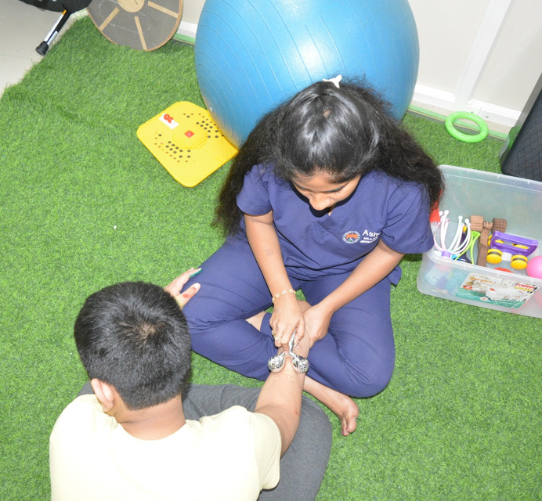Sensory Integration Therapy
Empowering Children Through Enhanced Sensory Processing
About Sensory Integration Therapy at Ashoka
Ashoka’s Sensory Integration Therapy is a personalized and evidence-based approach designed to help children overcome sensory processing challenges. Our therapy targets the fundamental sensory systems that influence movement, behavior, and overall well-being.
Understanding Sensory Integration
The sensory integration framework consists of eight sensory systems, with three playing a critical role in sensory processing challenges:
- Tactile System – Helps recognize touch, pressure, texture, and temperature.
- Proprioceptive System – Provides awareness of body position and movement through muscles and joints.
- Vestibular System – Located in the inner ear, responsible for balance, coordination, and spatial orientation.
Children experiencing sensory processing dysfunction may display:
✔ Sensory Modulation Challenges – Over- or under-reacting to sensory input.
✔ Sensory Discrimination Difficulties – Struggling to distinguish between different sensory inputs.
✔ Sensory-Based Motor Challenges – Difficulty in movement coordination and body stabilization.
At Ashoka’s Sensory Integration Therapy, we recognize these diverse challenges and offer customized interventions to improve sensory processing, enhancing focus, motor skills, and emotional regulation.
Sensory Integration Therapy




Key Features of Ashoka’s Sensory Integration Therapy
Our therapy is designed specifically for children with autism and other sensory challenges, incorporating the following core elements:
Individualized Assessment
- Comprehensive evaluation to identify the child’s unique sensory processing challenges.
- A tailored therapy plan based on specific needs.
Multi-Sensory Approach
- Activities stimulating multiple senses (sight, sound, touch, taste, and smell).
- Engaging exercises that enhance overall sensory development.
Focus on Core Sensory Systems
- Tactile System – Addresses sensitivity to textures and temperatures.
- Proprioceptive System – Enhances awareness of body position and movement.
- Vestibular System – Improves balance, coordination, and spatial orientation.
Sensory Diet
- A personalized set of activities integrated into daily routines.
- Helps regulate sensory needs throughout the day.
Gradual Desensitization
- Step-by-step exposure to sensory stimuli.
- Helps reduce sensory overload and increase tolerance.
Environmental Modifications
- Adjustments in lighting, sound, and sensory-friendly spaces to enhance comfort.
- Home-based strategies to create a calming environment.
Movement & Body Awareness Activities
- Activities like swinging, spinning, and rocking to stimulate sensory systems.
- Strengthens coordination and improves motor control.
Self-Regulation Techniques
- Teaching deep pressure exercises, breathing techniques, and sensory breaks.
- Helps children cope with overwhelming sensory input.
Parental Involvement & Training
- Parents are active participants in therapy sessions.
- Guidance on sensory-friendly home practices to reinforce progress.
Play-Based Therapy
- Engaging games and fun activities to keep therapy interactive and enjoyable.
- Encourages learning through movement and play.
Goal-Oriented Interventions
- Each session is structured around measurable goals tailored to the child’s needs.
- Regular progress monitoring and adjustments ensure optimal outcomes.
Benefits of Sensory Integration Therapy at Ashoka
Our approach to sensory integration therapy offers a wide range of life-changing benefits for children with autism:
- Enhanced Sensory Processing – Improved responses to different sensory stimuli.
- Better Self-Regulation – Greater emotional control and fewer sensory meltdowns.
- Increased Sensory Tolerance – Helps children adapt to overwhelming stimuli.
- Improved Attention & Focus – Supports learning and task engagement.
- Refined Motor Skills – Enhances gross and fine motor development.
- Greater Social Engagement – Supports better peer interactions.
- Positive Behavioral Changes – Reduction in sensory-related disruptive behaviors.
- Enhanced Communication Skills – Indirectly aids in language and social skills development.
- Increased Comfort in Daily Activities – Eases dressing, grooming, and eating challenges.
- Reduction in Repetitive Behaviors – Encourages engagement in meaningful activities.
- Overall Improved Quality of Life – Fosters independence and confidence.
Every child’s sensory processing journey is unique, and our therapy is adapted to their individual needs. Our multidisciplinary approach, including collaboration with occupational therapists, physiotherapists, speech therapists, and psychologists, ensures a holistic intervention plan.
Why Choose Ashoka’s Sensory Integration Therapy?
- Expert-Led Therapy – Specialists with extensive experience in sensory integration.
- Comprehensive, Individualized Approach – Therapy plans designed specifically for your child.
- Cutting-Edge Facilities – State-of-the-art sensory gyms and therapy tools.
- Parental Guidance & Home-Based Support – Involves families in the therapeutic process.
- Early Intervention for Maximum Impact – Timely identification and therapy for long-term success.
- Evidence-Based Techniques – Proven strategies to support sensory development.
At Ashoka’s Sensory Integration Therapy, we help children unlock their full potential by fostering better sensory processing, motor skills, and emotional well-being.
